Tobacco to 21

In a a time of increased partisanship (prejudice in favor of a particular cause; bias) in politics, the things that both parties agree on are even more important. With a two party system, if one party supports something and the other does not, it is very difficult to get something through congress. If both parties support something it is easier, this is a relativity simple idea. By finding the ground in the middle, congress, working with the president, can move more legislation from a bill to a law than they can if only one party supports an idea.

An area that has overwhelming support on both sides of the aisle is raising the national age to purchase tobacco products to 21 instead of 18. GOP Senators Mitt Romney of Utah and Todd Young of Indiana, and Democrat senators Brian Schatz of Hawaii and Dick Durbin of Illinois all had written bills that would raise the age to purchase tobacco products and the current law that has just been passed is a combination of all of them. President Trump, a republican president fully supported the bill. This bipartisanship was key in getting the law into effect quickly. According to Gallup, every single age category, gender, and race, support the bill with the lowest amount of support coming from males ages 18-29 at 66%.
According to The National Review, the sending bill that will fund the government for the fiscal year of 2020 contained the bill to raise the tobacco purchasing age to 21 and passed with a 71-23 vote.

Proponents of the bill say that it will drastically reduce teen tobacco use and thus reduce the amount of people that use tobacco later in life. According to Tobacco Free Kids, 95% of life long smokers started smoking before the age of 21. They also say that raising the age to 21 will reduce the amount of high school students that are able to get tobacco by having an older friend buy tobacco products for them as it is likely that they have friends that are 18, but unlikely that they will have friends that are 21. The raising of the tobacco age also includes the purchases of e-cigarettes, what many say cause the panic behind the bill. As many contain nicotine, they are addictive and teens are more susceptible than most to succumbing to the addiction because of their still developing brain. They argue that because of the newness of e-cigarettes, we don’t know the long term health effects and that the sharp upward spike of teen use is troubling because of the success that there has been in reducing the number that smoke traditional cigarettes.
The other side of the argument says that this bill is doing nothing but virtue signaling. According to the LA Times, restricting something based on age has never really accomplished what the goal of the bill was supposed to accomplish. It sites the drinking age as a prime example. It says that even though fatalities caused by driving under the influence decreased for those between the ages of 18-20, it went up for those ages 21-25. The goal of the bill was to decrease fatalities that resulted from consuming alcohol, which it did not, it actually increased them. It also sites a law in the city of Monrovia that passed a daytime youth curfew that was well received amount the community for supposedly cutting crime and truancy. But long-term studies found that crime actually fell more during non-curfew hours. It sites several more studies that, they say, show that this law will fail just as the others have in the past.
The question is no longer if the law will get passed, since it did with its overwhelming bipartisan support, but rather, will it accomplish what it set out to do?



